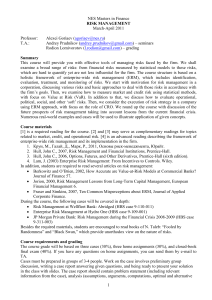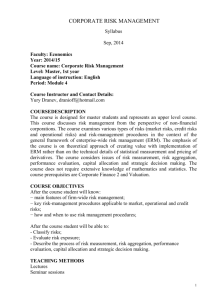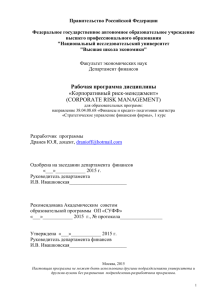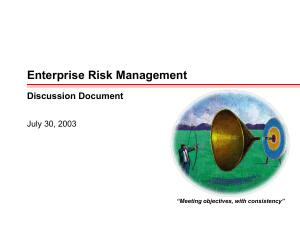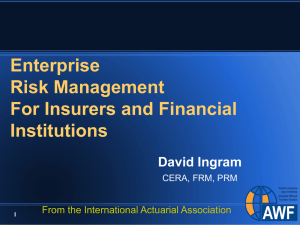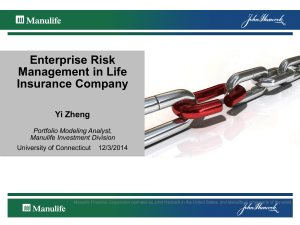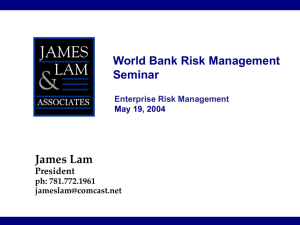Course information
advertisement
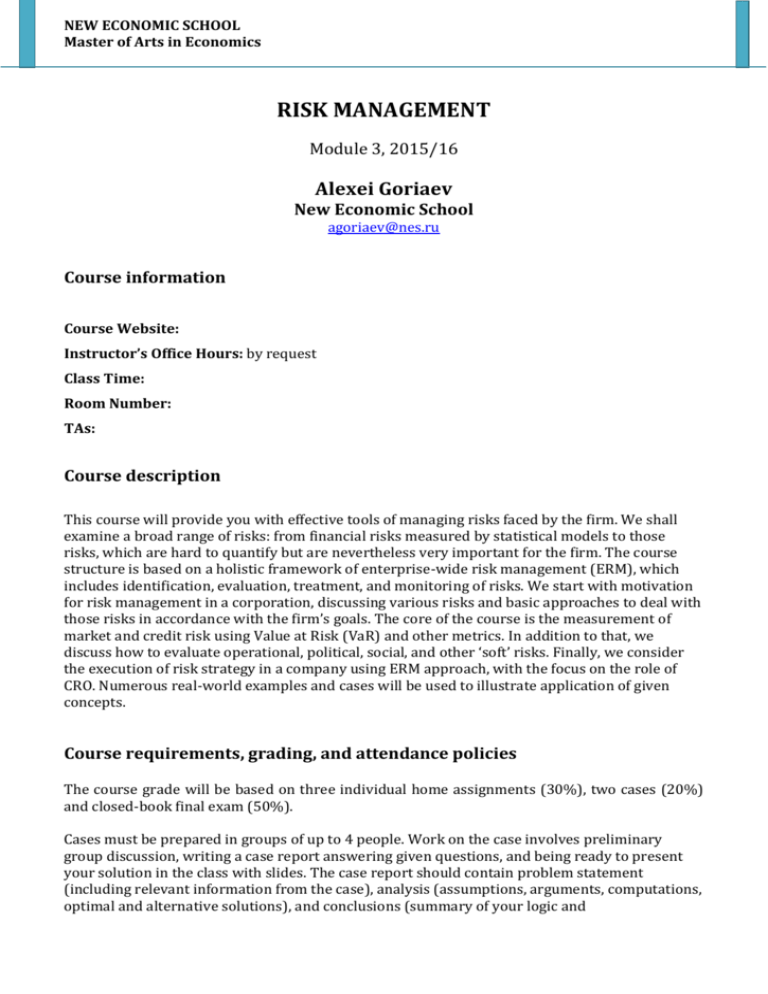
NEW ECONOMIC SCHOOL Master of Arts in Economics RISK MANAGEMENT Module 3, 2015/16 Alexei Goriaev New Economic School agoriaev@nes.ru Course information Course Website: Instructor’s Office Hours: by request Class Time: Room Number: TAs: Course description This course will provide you with effective tools of managing risks faced by the firm. We shall examine a broad range of risks: from financial risks measured by statistical models to those risks, which are hard to quantify but are nevertheless very important for the firm. The course structure is based on a holistic framework of enterprise-wide risk management (ERM), which includes identification, evaluation, treatment, and monitoring of risks. We start with motivation for risk management in a corporation, discussing various risks and basic approaches to deal with those risks in accordance with the firm’s goals. The core of the course is the measurement of market and credit risk using Value at Risk (VaR) and other metrics. In addition to that, we discuss how to evaluate operational, political, social, and other ‘soft’ risks. Finally, we consider the execution of risk strategy in a company using ERM approach, with the focus on the role of CRO. Numerous real-world examples and cases will be used to illustrate application of given concepts. Course requirements, grading, and attendance policies The course grade will be based on three individual home assignments (30%), two cases (20%) and closed-book final exam (50%). Cases must be prepared in groups of up to 4 people. Work on the case involves preliminary group discussion, writing a case report answering given questions, and being ready to present your solution in the class with slides. The case report should contain problem statement (including relevant information from the case), analysis (assumptions, arguments, computations, optimal and alternative solutions), and conclusions (summary of your logic and NEW ECONOMIC SCHOOL Master of Arts in Economics recommendations). It should be written as executive report to your superior; the maximum length is 3 pages (all tables and supporting data can be put into a separate appendix). The report must be based on information contained in the case and your own analysis, not on someone else’s solutions that may be available at the web (I will check those to ensure there are no similarities). It should be submitted by the beginning of the class discussing the case. Each case contributes 10% to the total points for the grade. If someone is not ready to discuss the case in the class and cannot answer two questions in a row, he or she receives zero points for a given case. To pass the course, one should score at least 30% for the exam. Those attending less than 50% of the lectures will not be allowed to take a make-up exam. Active class participation may add up to 5% bonus points (note that quality rather than quantity of your interventions will count). Course contents Class Topic Reading 1-2 Motivation for risk management. Mapping risks that corporations face. Main methods of treating risks. Risk management as a part of corporate strategy Mini-case: American Barrick [1] ch.1-2 [2] ch.1-2 [4] ch.1,3 3-4 Hand in home assignment 1 Market risk. Exposure: beta, duration, delta. Volatility: historical, EWMA, GARCH, implied. VaR: delta-normal, historical, and Monte Carlo approaches. Back-testing. [1] ch.5, 7 (161-182) [2] ch.5, 8.1-8.6, 9-10 [3] ch.18-19 [4] ch.14 5-6 Hand in home assignment 2 Market risk: practical aspects and post-crisis changes. Alternative risk measures. Stress testing. Liquidity risk. Mini-cases: LTCM and Lehman Brothers [1] ch.7 (183-188), 14, 10 (238-245) [2] ch.8.7, 15 7-8 Hand in case solution&be ready to discuss: Wellfleet Bank [1] ch.10-12 Specifics of credit risk. Credit risk: modeling recovery rate, [2] ch.11-13 credit exposure and probability of default. Credit ratings. [3] ch.20-21 [4] ch.15 9-10 Hand in home assignment 3 Scoring models. Modeling credit spread. The advanced models of credit risk: CreditMetrics and KMV. Credit derivatives. [1] ch.13 [2] ch.14, 15.1-15.6 [4] ch.16 11- Hand in case solution&be ready to discuss: JP Morgan Chase [4] ch.5-13 12 Operational risk. Mini-cases: Barings, Societe Generale, Madoff. Other ‘soft’ risks: political, legal, environmental, social, etc. NEW ECONOMIC SCHOOL Master of Arts in Economics Class Topic Reading 13- The practice of enterprise risk management (ERM). Role of [1] 377-387 14 CRO. Risk dashboard, KRI and EWI. Use of risk-adjusted [2] ch.18 measures such as RAROC for performance evaluation, [3] ch.32 managerial compensation, intra-firm capital allocation, etc. Mini-case: Hydro One Practical aspects of risk management. Lessons from the crisis. The future of risk management. Description of course methodology Main topics and selected cases will be studied during the lectures. Students should be prepared to discuss the cases assigned to them for the grade and present case solutions. Seminars will be devoted to discussions of various examples, problems, applied materials, etc. Students are expected to be prepared for each class by doing pre-reading of the assigned materials. Sample tasks for course evaluation Sample question from Home assignment 2: Compute 5% VaR for 1-day horizon for each day over your sample period (except for the first year necessary for initial calculations) using the following approaches: Historical modeling with 1 year sample period Filtered historical modeling with 1 year sample period Delta-normal approach with simple volatility computed in the previous question Delta-normal approach with EWMA volatility computed in the previous question Sample question from Case 1: Assess the GGC loan proposal by discussing its advantages and potential risks. Analyze the economic revenue and profit from the deal calculated by the bank’s managers. Which factors may make these numbers lower than expected? Should Wellfleet accept the deal or not? Sample question from the exam: Many experts like to stress the importance of “black swans” or “unknown unknowns” (when we haven’t even thought of the possible event) for the corporate risk management. How can a company deal with this? Suggest and discuss at least three different approaches. Course materials Required textbooks and materials 1. Hull, John C., Risk Management and Financial Institutions, Prentice-Hall. 2. Hull, John C., Options, Futures, and Other Derivatives, Prentice-Hall. 3. Круи, М., Галай, Д., Марк, Р., 2011, Основы риск-менеджмента, Юрайт. NEW ECONOMIC SCHOOL Master of Arts in Economics Additional materials 4. Энциклопедия финансового риск-менеджмента. Под ред. А.А.Лобанова и А.В.Чугунова. – М: Альпина Паблишер Academic integrity policy Cheating, plagiarism, and any other violations of academic ethics at NES are not tolerated.
